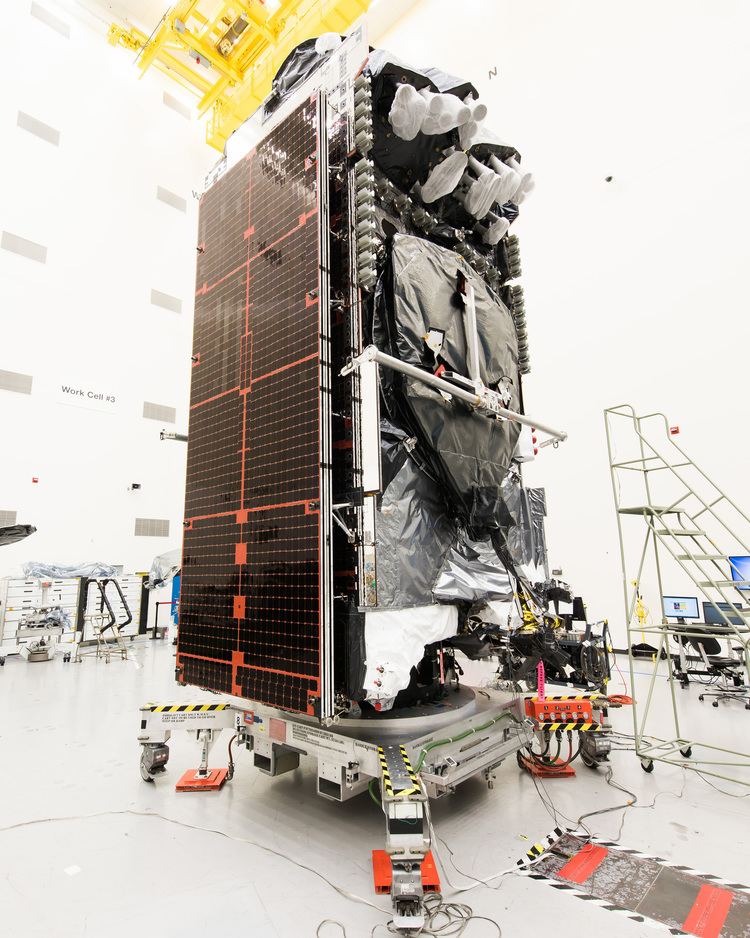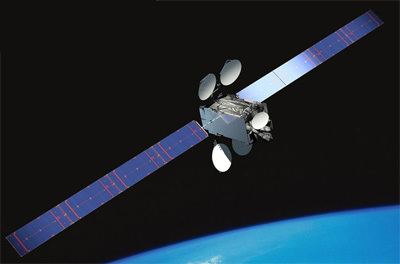Names IS-29e SATCAT no. 41308 Launch date 27 January 2016 Launch mass 6,552 kg Manufacturer Boeing | Mission type Communication COSPAR ID 2016-004A Website Intelsat IS-29e Period 24 hours Launch mass 6,552 kg Bus Boeing 702 | |
 | ||
Similar Intelsat 33e, Intelsat 36, Intelsat 34, Belintersat‑1, Star One D1 | ||
Ariane 5 eca va228 launches intelsat 29e satellite
Intelsat 29e, also known as IS-29e is a high throughput geostationary communications satellite designed and manufactured by Boeing on the BSS-702MP platform. It is the first satellite of the EpicNG service, and covers CONUS, Latin America and North America from the 50° West longitude, where it is replaced Intelsat 1R. It also replaced Intelsat 805 which was moved from 56.5° West to 169° East. It has a mixed C band, Ku band and Ka band payload with all bands featuring wide and the Ku also featuring spot beams.
Contents

Satellite description

The spacecraft was designed and manufactured by Boeing on the Boeing 702MP satellite bus. It has a launch mass of 6,552 kg (14,445 lb) and a design life of more than 15 years. When stowed for launch, the satellite measures 7.5 by 3 by 2 metres (24.6 ft × 9.8 ft × 6.6 ft).

It is powered by two wings, with four panels each, of triple-junction GsAs solar cells, that span 44 metres (144 ft) when deployed. Intelsat 29e can generate 15.8 Kw at the end of its expected life and has four Li-ion batteries.

This three axis stabilized platform has a bi-propellant propulsion system using NTO/N2O4. It has a 449 N (101 lbf) Liquid Apogee Engine for orbit raising and 22 N (4.9 lbf) and 4 N (0.90 lbf) thrusters for station keeping. The propellant tanks hold approximately 1,550 kg (3,420 lb) of N2O4 and 2,000 kg (4,400 lb) of NTO. This new series of geosynchronous satellites lack an Earth Sensor, and thus enter Earth pointing attitude based on the orbital position as determined by the star tracker.

It's payload is the first high throughput EpicNG deployment, of the six planned as of January 2016. The EpicNG is characterized by the implementation of frequency reuse thanks to a mix of frequency and polarization in small spot beams. Not only applied to the classical HTS Ka band, but also applying the same technique in Ku band and C band. The EpicNG series also keep the use of wide beams to offer high throughput and broadcast capabilities in the same satellite.
The payload is designed and manufactured by Boeing based on the work of the WGS constellation. It most innovative feature of this fully digital payload, is that it enables to dynamically link two sites through a single satellite without needing to go through a ground station.
In the case of Intelsat 29e, the C band side has 14 physical transponders with a bandwidth 864 MHz Ku or 24 transponder equivalent. It covers South America in a wide beam. The Ku band has physical 56 transponders (249 transponder equivalent) for a total bandwidth of 9,395 MHz. The Ku spot beams cover the Americas and the North Atlantic route, while a wide beam can broadcast to North America and North Atlantic. The The Ka band payload has 450 MHz of bandwidth on a global beam centered at its position.
History
In July 2009, Intelsat became the first customer of the Boeing 702MP platform, when it place an order for four spacecrafts, Intelsat 21, Intelsat 22, Intelsat 27 and what would become Intelsat 29e.
On June 7, 2012, Intelsat announced the EpicNG platform. It would improve available bandwidth thanks to the use of frequency reuse and polarization and feature spot and wide beams, enabling high bandwidth and broadcast applications on a backward compatible way. The first two satellites would be Intelsat 29e and Intelsat 33e. On September 4, 2012, Intelsat and Boeing announced that Intelsat 29e, the first EpicNG satellite, would be made by Boeing on the 702MP platform, completing the 2009 order of four such satellites.
In May 2013 Intelsat ordered a further four 702MP-based EpicNG satellites, Intelsat 32e, Intelsat 33e and two as of August 2016 unnamed spacecraft. And in July 2014 a sixth Epic was ordered, Intelsat 35e.
During 2013, Intelsat signed a contract to launch Intelsat 29e aboard an Ariane 5. Brian Sing, was assigned as Senior Program Manager for the launch aboard the rocket.
During June 2015, the payload was integrated and went through testing. First it was deployed and stowed back, then it went through sound environment and vibration testing, and finally deployment was tested again. On July 14, 2015, the payload integration to the satellite bus and its non-environmental testing was completed. It would then go through the environmental testing campaign which would start with thermal vacuum chamber tests. It is a Boeing design based on the work of the WGS constellation.
On December 10, 2015, Intelsat announced that the launch date for Intelsat 29e had been set for January 27, 2016.
After four years of project development, Intelsat 29e arrived to the launch site aboard an Antonov 124 on December 11, 2015. At the site's Payload Processing Facility, Boeing technicians unpackaged the spacecraft and associated equipment and performed a quick fit check. On the second weeks of January, 2016, the satellite was fueled and installed in the rocket payload adapter. By January 21, the spacecraft had been moved to the Final Assembly Building where it was mated to the launcher rocket. On January 26, 2016 all checks were completed and the launch review for the next day was completed.
On January 27, 2016, at 23:20 UTC, an Ariane 5 ECA launched from the ELA-3 launch pad at the Guiana Space Center. Intelsat 29e, its only passenger, separated 30 minutes later, and the satellite first signals were received shortly afterwards by the Kumsan, South Korea, Ground Station. The next two days were spent evaluating the health of the satellite and determining the exact orbit, then a series of nine orbital maneuvers to raise the perigee to 35,786 km (22,236 mi) were started. This orbit circularization would consume approximately 2,500 kg (5,500 lb) of propellant.
When it reached its test position at 49.7° West, it deployed its antennas and solar panels. In a March 28, 2016 blog by Duy Nguyen, Senior Program Manager, it was announced that Intelsat 29e had successfully passed the 30-day payload in-orbit testing (PIOT) and was undergoing the first performance testing with an anchor customer. It had been particularly challenging because it was the first digital configurable payload for Intelsat, and they had to also test the ground segment for the first time.
